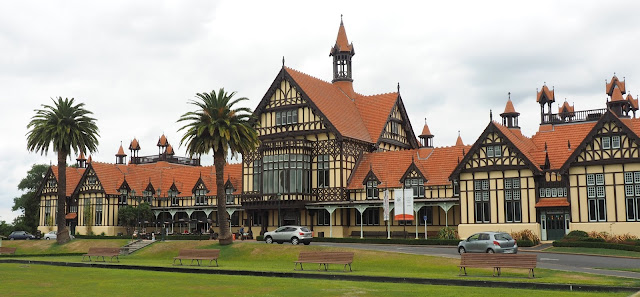And so the Great Road Trip begins: four of us, three English, one Kiwi, in a red Rav setting out to show two of the Poms what is great about New Zealand. Not much of it is booked ahead, and the route is only roughly planned, linking the usual tourist hot-spots all the way down to the bottom of the South Island. (Sorry, Bay of Islands - there's no time for heading north of Auckland on this trip. Blame my Mainlander predilections.)
First stop, after pausing at Tirau to note that a giant corrugated ram has joined the ewe and the sheepdog in the main street, was of course Rotorua. It's always in danger, for me anyway, of seeming a cliché - steam, sulphur, geysers, boiling mud, ho hum - so it's good to see it through fresh eyes as the startling place it really is.
The cultural aspect too: it's easy to be cynical about the touristification of Maori but, having seen plenty of other countries' indigenous presentations over the last few years, I know they're not alone in incorporating modern elements into their displays. It's not as if culture stands still, after all - who says that, to be authentic, it should be frozen in time at, say, 1840?
So, when we went to Te Puia for the concert in the whare nui on the marae, I didn't sneer at the costumes, which looked a lot more colourful and decorative than they used to. Instead, I just enjoyed the show which besides being very professional, really did look as though the performers were enjoying themselves. What I did sneer at was the Chinese tourist in the row in front of me who watched the entire thing on the screen of her iPad. Tch.
I was really quite startled, when we went to Ohinemutu, to hear water boiling beneath the pavers out in front of the church [Update: in November, geysers unexpectedly erupted in the lake just off the shore from the village - only briefly, but reaching up to 30 metres.] The church itself is well worth a visit for its Maori decoration, the volunteer guide there, who lives in the village, very chatty and informative - and scathing about the tour operators who bring coachloads to visit and don't deign to give the voluntary donation.
The museum in the old Bath House is ok, the most interesting bit being the downstairs where there's a good exhibition of its spa heydays, which look a bit hard-core for us modern softies (today's sanitised Polynesian Pools much more to my taste). The building itself is lovely, a very grand combination of Victorian mock Tudor with a Maori colour scheme. [Another update: after damage caused by November's 7.8 earthquake in Kaikoura, the museum will be closed for repairs for at least 6 months. 2016 was seismic literally, as well as figuratively.]
The main advantage of the Lady Knox geyser over Pohutu and the others is of course that it's reliable, set off daily at 10.15am by bars of soap being dropped into it to reduce the surface tension of the water. The disadvantage is that, because it's predictable, there are hordes of (mostly Chinese) tourists and there's a lot of shuffling and waiting involved. Much better is to light out on a walk around Waiotapu, where the colours of the pools are really strong and striking, and there's the peace and space to appreciate this amazing place.







No comments:
Post a Comment